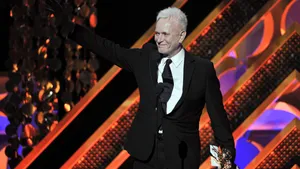Seeing LGBTQ+ people in ads, television shows, and films leads to greater acceptance.
A new study from GLAAD and Procter & Gamble, "LGBTQ Inclusion in Advertising and Media," found that straight cisgender people who had been exposed to LGBTQ+ people in media over the past few years were more likely to accept members of this demographic and be supportive of the issues they face.
The national survey, held between November and December of last year, gathered responses from 2,031 non-LGBTQ+ U.S. adults (18 and over) through Cint, the world's largest sample exchange platform. It found that among those exposed to LGBTQ+ folks in media, 48 percent reported being more accepting of gays and lesbians, compared with a 35 percent acceptance rate among those who had not.
For those who had recently seen LGBTQ+ representation, acceptance rates were also higher toward bisexual people (45 percent versus 31 percent), nonbinary people (41 percent versus 30 percent), and equal rights for LGBTQ+ people (80 percent versus 70 percent).
The power of visibility also extended to personal relationships. The survey found that 72 percent of those who had recently seen LGBTQ+ representation reported being comfortable with learning the existence of LGBTQ+ family members, compared to 66 percent.
Additionally, 79 percent of the LGBTQ+ exposed reported being comfortable with having a rainbow family as neighbors (compared to 72 percent), 69 percent would be comfortable starting a conversation with a person whose gender was ambiguous (compared to 60 percent), and 73 percent would be comfortable with learning their doctor is gay or bi (compared to 67 percent).
Overwhelmingly, respondents also said seeing LGBTQ+ people in ads reflected highly on the company -- 82 percent said it demonstrated a value for all types of diversity, and 85 percent saw a commitment to offering products for all kinds of customers.
"The findings of this study send a strong message to brands and media outlets that including LGBTQ people in ads, films, and TV is good for business and good for the world," said Sarah Kate Ellis, president and CEO of GLAAD, an organization that promotes positive LGBTQ+ representation in media. "During the COVID-19 pandemic, when media consumption is up and when media outlets serve as lifelines for LGBTQ people in isolation, companies should recognize that now is the right time to grow the quality and quantity of LGBTQ people in advertising."
With the release of the findings, P&G Chief Brand Officer Marc Pritchard committed to "building LGBTQ marketing into the fabric of how we build brands by understanding invaluable insights that not only responsibly represent the values and culture of the LGBTQ community, but also link closely to the character of our brands -- never stereotyping, never misappropriating. But we all have a lot to learn and we are truly at the beginning of our journey to master LGBTQ inclusion in our brand-building efforts."
P&G is the world's largest advertiser, with a portfolio of household products including Bounty paper towels, Crest toothpaste, Febreze, and Olay moisturizer.
With the report's numbers underscoring the importance of visibility, GLAAD, P&G, and the Association of National Advertisers' Alliance for Inclusive and Multicultural Marketing announced they would be developing best practices and standards for the advertising industry in regard to LGBTQ+ inclusion.




































































Charlie Kirk DID say stoning gay people was the 'perfect law' — and these other heinous quotes